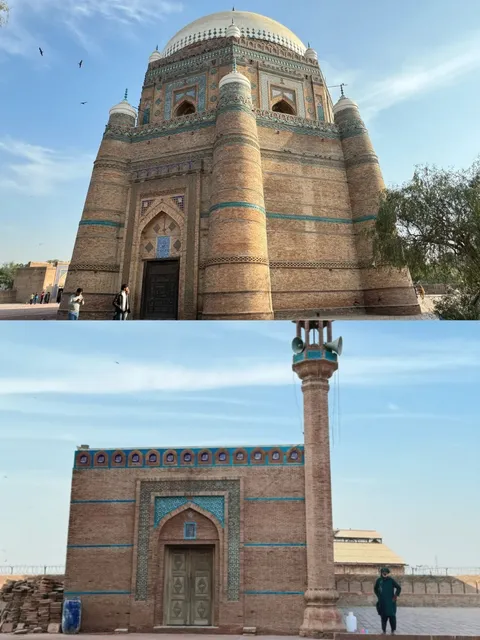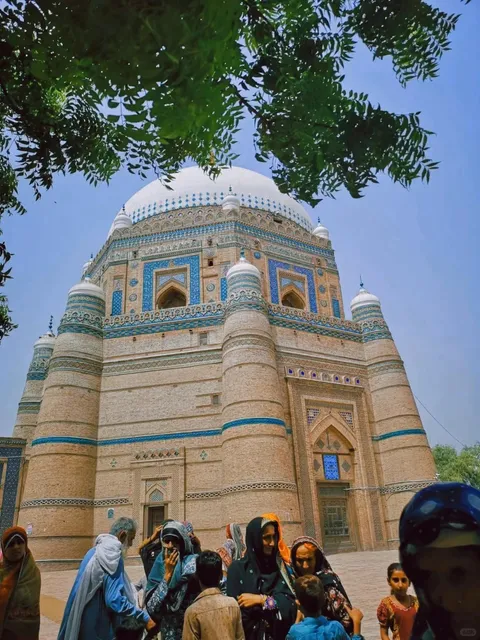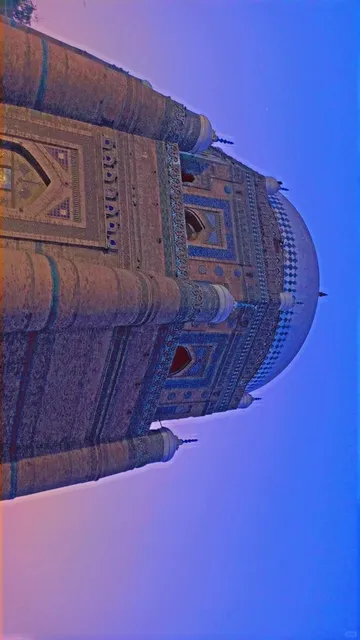The mausoleum of Shah Rukn-e Alam is located in central Multan and houses the graves of the Sufi saint Sheikh Rukn-ud-Din Abul Fateh (1251-1335) and dozens of his disciples and family members. Built from 1320-24, it is commonly ranked among the key monuments of Indo-Islamic architecture, inspiring later memorials such as the Tughluq tombs in Delhi and the numerous mausolea at Uch Sharif.
By the early 12th century the Punjab area, and Multan in particular, was widely regarded as a center of Sufi learning with numerous mausoleums of Sufi wali (saints) dotting the landscape. It was popularly believed that the spiritual influence of a saint (his baraka) continued to radiate even after death, making pilgrimages to such tombs a salubrious experience. As tombs grew to encompass a social function—as places for a saint's disciples and family members to gather and reaffirm their shared beliefs and spiritual lineages—it became more and more necessary for tombs to be large, durable, and integrated with the surrounding community. For instance, the saint's own grandfather, Baha-ud-din Zakariya (c. 1170-1262) was laid to rest in a grand tomb within Multan's urban fabric, where it served as the centerpiece of annual fairs and frequent pilgrimages. It was also lofty and visible from a great distance, in accordance with the saint's elevated stature.
Tomb construction was a costly affair; Zakariya was apparently able to sponsor the construction of his own tomb out of his own funds, but that was fairly unusual. More often local rulers or a saint’s spiritual heirs would shoulder the burden. Rukn-e Alam’s tomb presents a puzzle as it is exceptionally large—the tomb measures 35 meters from ground to roof and is 27 meters in diameter, far larger than any other Sufi tomb in Multan before or hence. One explanation for this is that the tomb may have originally been intended for Ghazi-ad-din Tughluq, the regional governor of Dipalpur, who had access to greater revenue streams than any Sufi saint. According to this interpretation, Tughluq began constructing the tomb in 1320. At the same time, Tughluq grew tempted with the prospect of higher office when the neighboring Delhi Sultanate showed signs of weakness. Sensing an opportunity, Tughluq invaded and successfully claimed the throne, installing himself as the first of the so-called Tughluq emperors, a dynasty that survived until 1413.
Tughluq's rule was energetic but short-lived; upon his death in 1325 he was buried in Delhi. As his tomb at Multan was no longer needed, it may have been gifted by Tughluq's heir, Firuz Shah, to the descendants of Rukn-e Alam, who reinterred the saint there in the 1350s (Rukn was originally buried in Zakaryia’s tomb alongside his spiritual mentor). If this is true, the grand nature of Rukn’s tomb may be a historical accident, as his followers were able to gain control of an empty tomb suitable to their needs.
However, Ahmad Nabi Khan is of the opinion that Tughluq's involvement is spurious. He notes that Tughluq was not in uncontested control of Multan and that contemporary chroniclers such as Ibn Battuta omit mention of a tomb, even though Battuta remarked on a much smaller mosque (which no longer survives). Tughluq was also a devotee of the grandson of the Sufi master Baba Farid Ganj-i-Shakar; hence, it seems unlikely that his heirs would have given the tomb to anyone else. Furthermore, Tughluq was originally appointed to contain the ongoing threat posed by the Mongols. His constant forays into battle would have left him little time or opportunity to prepare a...
Read moreOverview:
The Tomb of Hadrat Shah Rukn-e-Alam, located in Multan, Pakistan, is one of the most significant architectural and spiritual landmarks in the region. Built between 1320 and 1324, this mausoleum is a masterpiece of early Islamic architecture and a revered pilgrimage site. It houses the remains of the Sufi saint Sheikh Rukn-ud-Din Abul Fateh, known as Shah Rukn-e-Alam, a prominent figure in the Sufi tradition.
Merits:
Architectural Significance: The tomb is an outstanding example of Tughlaq-era architecture, featuring intricate tile work, geometric designs, and a distinctive domed structure.
Historical Importance: It serves as a testament to the rich cultural and spiritual history of Multan and the region's role as a center of Islamic learning and Sufism.
Spiritual Significance: The tomb is a major pilgrimage site, attracting thousands of devotees who come to pay their respects and seek blessings.
Tourist Attraction: Its unique architecture and spiritual ambiance make it a popular destination for both domestic and international tourists.
Preservation: The site has been well-preserved, and restoration efforts have maintained its historical integrity.
Demerits:
Crowding: During religious festivals and special occasions, the tomb can become extremely crowded, which might detract from the spiritual experience.
Accessibility Issues: While the tomb is accessible, the surrounding infrastructure, such as parking and facilities, can sometimes be inadequate, especially during peak times.
Environmental Concerns: The increasing number of visitors has led to concerns about environmental sustainability, including waste management and preservation of the site.
Commercialization: The area around the tomb has seen commercial activity, which might affect the serene and spiritual atmosphere of the site.
Recommendations:
Sustainable Tourism: Implementing measures to manage tourist flow and ensure environmental sustainability is crucial.
Improved Facilities: Enhancing infrastructure, including better parking, restrooms, and waste management, can improve the visitor experience.
Cultural Awareness: Educating visitors about the historical and spiritual significance of the site can promote respectful behavior and preservation efforts.
Community Involvement: Engaging the local community in the maintenance and management of the site can foster a sense of ownership and pride.
Conclusion:
The Tomb of Hadrat Shah Rukn-e-Alam is a symbol of Multan's rich spiritual heritage and architectural brilliance. While it continues to attract devotees and tourists alike, ensuring sustainable practices and improved facilities will be key to preserving its sanctity and historical value for future...
Read moreThe Tomb of Shah Rukn-e-Alam is located in Multan, Punjab Pakistan, is the mausoleum of the Sufi saint Sheikh Rukon un Din Fateh. The shrine is considered to be the earliest example of Tughluq architecture and is one of the most impressive shrines in the Indian subcontinent. The shrine attracts over 100,000 pilgrims to the annual festival that commemorates his death. The tomb was built between 1320 and 1324 CE by Ghiyath al-Din Tughluq in the pre-Mughal architectural style. The tomb is considered the earliest example of Tughluq architecture, and pre-dates Tughluq monuments in Delhi.
Tomb was built when Ghiyath al-Din served as governor of Dipalpur, and likely was intended to serve as a tomb for himself before he became Emperor of the Delhi Sultanate. Rukn-e-Alam had initially been buried in the Shrine of Bahauddin Zakariya, however, the present tomb was gifted by Muhammad bin Tughluq to the descendants of Rukn-e-Alam, who had his remains interred in the shrine in 1330.
Multan had strong links to Persia and Afghanistan - links which are reflected in the heavy influence of Central Asian and Persian architectural styles found at the tomb, such as the use of brick, glazed tiles, and wooden roofs. The shrine represents the culmination of Multani funerary architecture that began with the Shrine of Khalid Walid near Kabirwala. The mausoleum is a three-tiered structure. Though the second octagonal tier is typical of Multan,the first tier in the shape of an octagon differs from the nearby Shrine of Bahauddin Zakariya and other earlier shrines which rests upon a square shaped base. The first tier is 15 metres in diameter, and features walls 4 feet thick. The first tier features bands of timber that create a visual break in the exterior brickwork. The octagonal first tier is buttressed by small minaret-shaped towers in each of its 8 corners that provide support to the structure, and narrow as they rise and surpass the height of the first tier. A second octagon rests upon the first tier that features small domes in each of the eight corners of the building. A third tier rests above the second, and is formed by a dome of 15 metres in diameter. The entire structure is 35 metres tall, with sloping walls. The dome is capped by a structure similar to...
Read more


